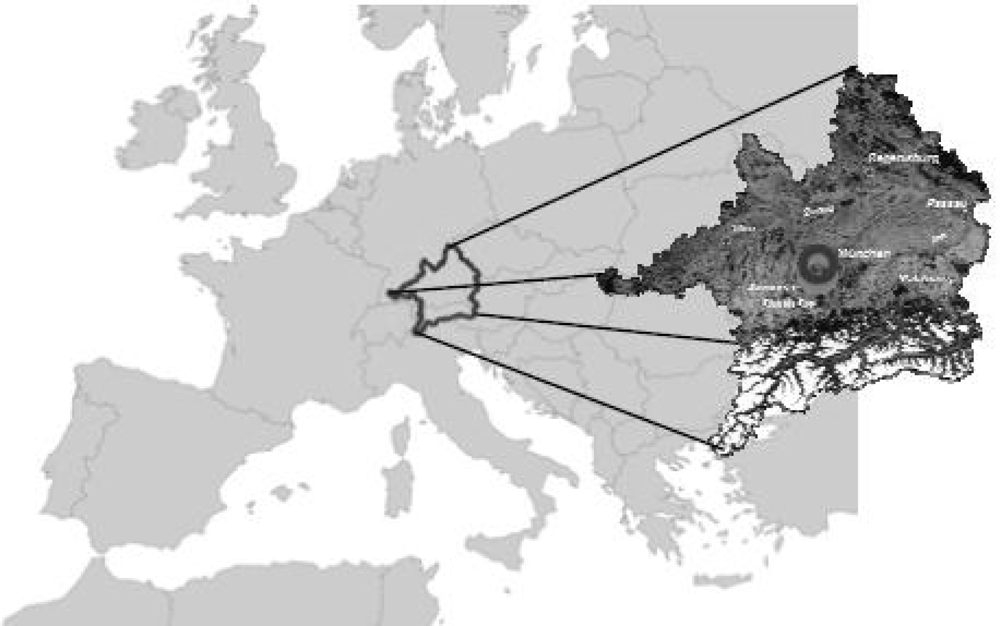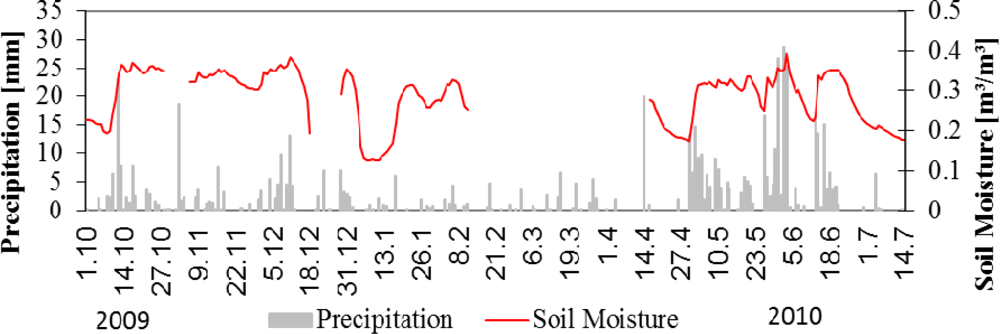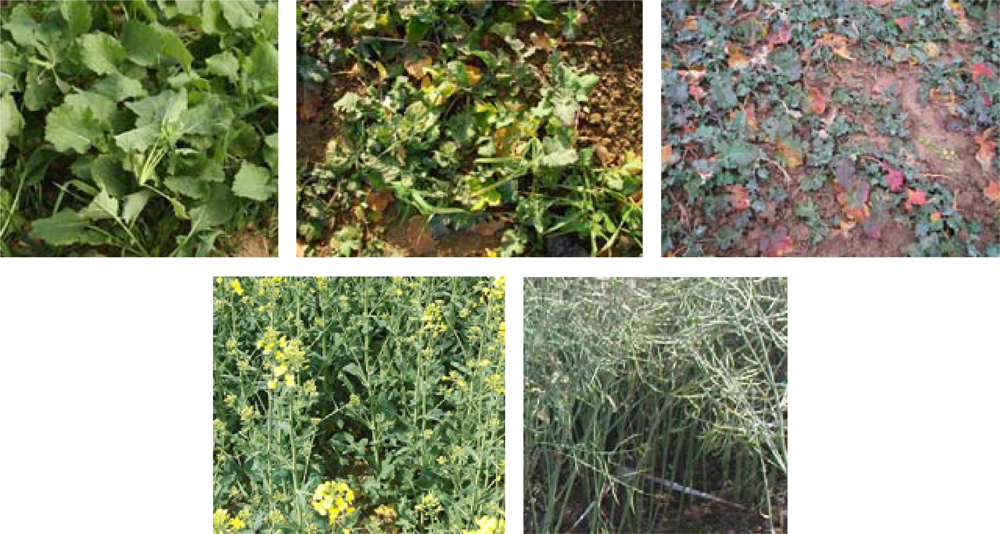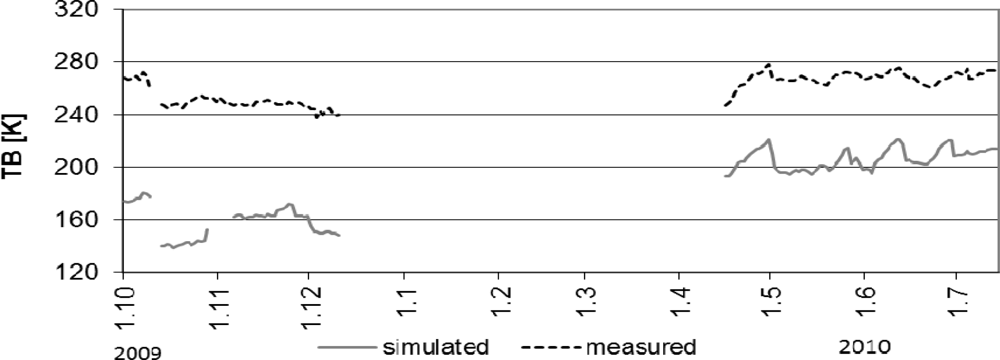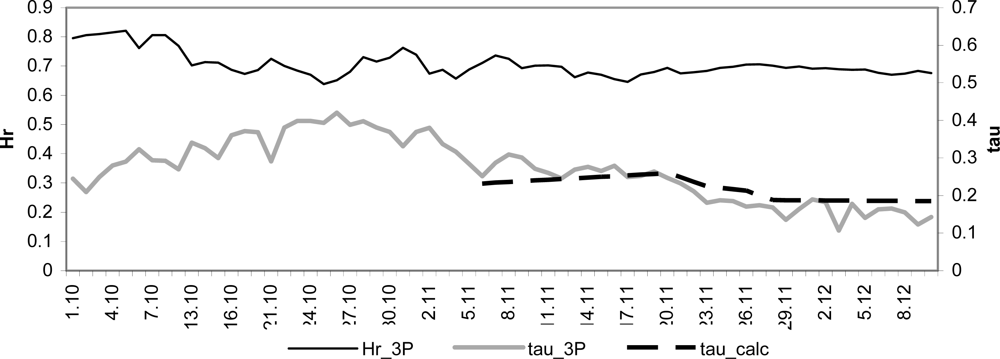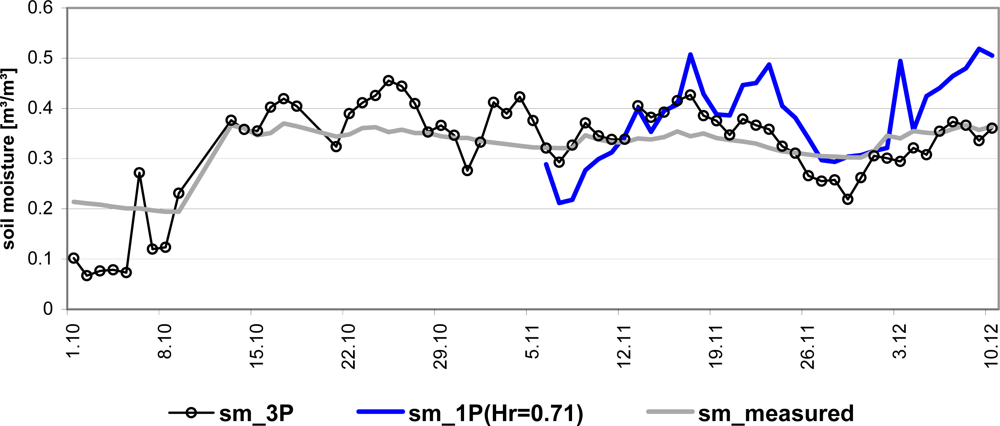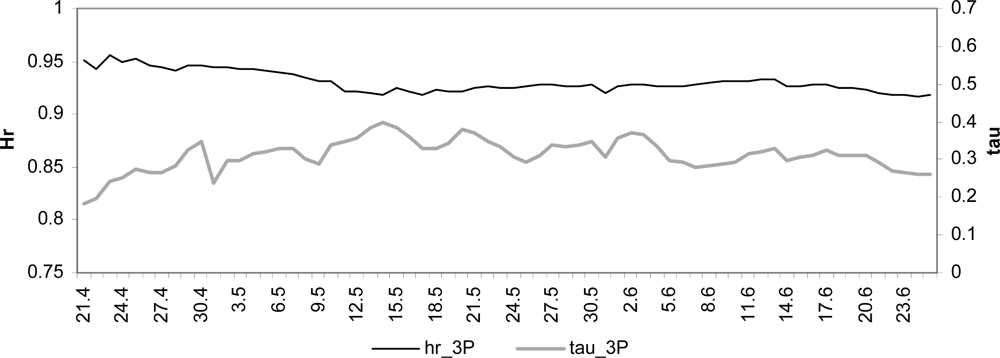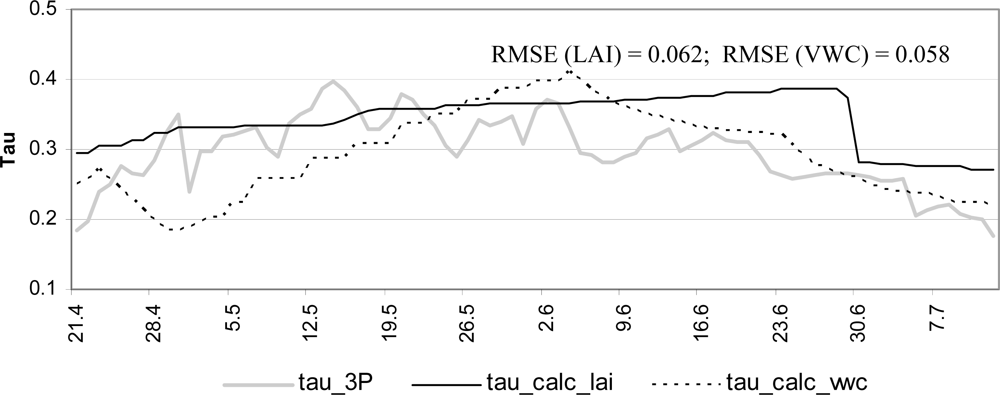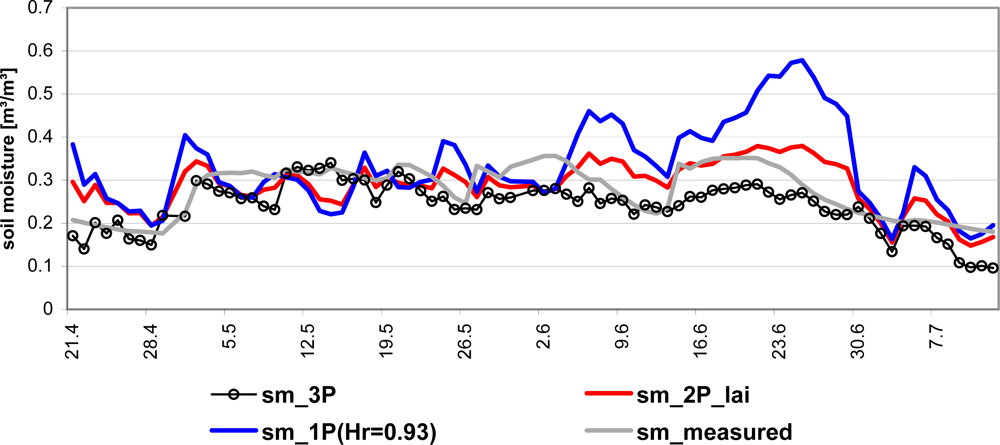3.1. Microwave Radiative Transfer Model
The microwave radiative transfer model L-MEB (
L-Band Microwave
Emission of the
Biosphere) is used in this study to simulate the microwave emission of a vegetated surface at L-Band. A detailed description of the model physics is provided by [
9], therefore only a brief overview is given here.
The basis of L-MEB is the Tau (τ)-Omega (ω) model [
9], which simulates the overall brightness temperature TB of a natural surface. This simple radiative transfer model uses two parameters to characterize the land surface: the vegetation optical depth τ and the single scattering albedo ω. They are used to parameterize vegetation attenuation and scattering effects. In several studies, the τ-ω-model has usually been found to be an accurate approach to model the L-Band emission from a vegetation canopy [
9].
Using that model, the overall emission from a two layer medium (soil and vegetation) is for each polarization (horizontal and vertical) the sum of the three terms soil emission attenuated (scattered and absorbed) by the vegetation layer, direct vegetation emission and vegetation emission reflected by the soil and attenuated again by the vegetation. It results in a polarized (p = h,v) brightness temperature (TB
P):
where T
C and T
G are the vegetation and the effective soil temperatures, r
Gp is the soil reflectivity, γ
p the vegetation attenuation factor, expressed by the vegetation optical depth and ω
p the vegetation single scattering albedo [
9].
The effective temperature of the soil is composed of a contribution of signals from different soil layers in different depths. According to the sensing depth variation with soil moisture content, the soil moisture is also taken into account here [
32]. Thus in L-MEB the following equation is used to parameterize T
G:
T
Deep here refers to the temperature at 50 cm and T
Surf to the temperature at 2 cm depth. Note, that
Equation (2) neglects multiple scattering effects within the soil layer [
9]. The higher the soil moisture is, the smaller is the depth, the radiation signal originates from [
12]. Accounting for this effect, Wigneron
et al. [
9] changed
Equation (2), parameterizing the factor C as function of soil moisture as follows:
where SM is the soil moisture in a depth of 5cm, which has a strong influence on emission characteristics of a surface. W
0 and bw
0 are semi-empirical parameters according to textural properties. Wigneron
et al. [
9] use the values w
0 = 0.3 m
3/m
3 and bw
0 = 0.3 as default values in L-MEB.
The reflectivity r
Gp at the soil/atmosphere interface is dependent upon the dielectric properties of the soil, originating from the dielectric roughness that depends on soil moisture, temperature, salinity, texture and geometrical roughness [
16]. Referring to [
33], the dielectric roughness is a function of the dielectric permittivity ε
S and of surface roughness effects. For the lower frequency range (1–20 GHz), several models have been developed to relate ε
S to soil parameters such as moisture, bulk density or proportion of sand and clay. In L-MEB the model of DOBSON [
34] or MIRONOV [
35] is used to calculate ε
S. Freezing also affects ε
S seriously, but is not accounted for within this study [
33].
In L-MEB the geometrical roughness is expressed through the parameters H
r (mean roughness), N
H,V (polarization dependent roughness), and Q
R (frequency dependent roughness). The latter has no influence in the region of 1.4 GHz and thus is set to zero in L-MEB [
30]. According to [
30], there is an exponential relation between the standard deviation of heights of the soil surface s and H
r. According to that functional relation, for the case of the Puch experiment, the measured s in the field would correspond to a roughness parameter H
r of approximately 0.5.
In the L-Band the scattering effects, represented by the single scattering albedo ω
p (where the subscript
P stands for polarization) are generally found in the literature to be low. For most low vegetation types, ω
p is below 0.05 [
9]. The vegetation attenuation factor γ
p is mainly expressed by the vegetation optical depth τ
p through the equation
with τ
p as vegetation optical depth and θ as incidence angle. As presented in the following, τ
p is expressed as a function of the overall vegetation optical depth at nadir (θ = 0°).
τp is generally found to be linearly related to the total vegetation water content VWC [kg/m2], using the b-parameter. For calculation of the vegetation optical depth through τ = b × VWC, a value of b = 0.12 ± 0.03 was found to be representative for most agricultural crops.
Some results of previous studies showed a strong relationship between vegetation optical depth and LAI. Through this, and because of the relationship between LAI and VWC (R
2 = 0.95 for fallow at SMOSREX [
10]), it is possible to calculate the vegetation optical depth from LAI through the linear equation:
Although the calculation of the vegetation optical depth with the water content is assumed to be more stable, in this study we decided to retrieve τ from the LAI because the LAI can be derived on the global scale from satellite data which is important for the global application of SMOS.
3.2. Methods
Due to the lack of L-MEB parameterizations for rape in a first step the brightness temperature modeling ability of L-MEB over winter oilseed rape was tested by using the SMOS default parameters for Central European crops to parameterize L-MEB and compare the simulated with measured brightness temperatures. After that it was tried to develop a better L-MEB parameterization for the land use winter oilseed rape. In order to do that, a sensitivity study was conducted to find the parameters with the most pronounced effect on the modeling. Next, different parameter retrievals are performed to estimate the L-MEB parameters needed for a proper modeling. In the end, the soil moisture retrieval capabilities of the new parameterization are assessed.
To test the suitability of the SMOS default parameters for Central European crops that are also used in the SMOS L2 soil moisture retrieval algorithm (
Table 3) [
36] for the radiative transfer modeling over winter oilseed rape, L-MEB was used with the default parameters to model the brightness temperatures in a simple forward modeling approach. The results are compared with the measured brightness temperatures from the radiometer ELBARA II. To enable a comparison with other retrievals carried out later, L-MEB is also used to assess the soil moisture retrieval performance of the default parameters in a one parameter retrieval. The parameters in
Table 3 correspond to the default values as described in [
36] that are in accordance with the operational version of the SMOS L2 soil moisture processor. As the H
r value is implemented as a piecewise function of soil moisture in the SMOS L2 soil moisture processor, the H
r value in
Table 3 corresponds to the maximum value of H
r that is being used in the processor.
The above mentioned continuous soil moisture measurements in 5 cm depth and the soil temperature measurements in 2 cm and 50 cm depth were used as input for the model together with the LAI measurements that were interpolated. The soil parameters and the air temperature that are needed for the modeling were also taken from the measurements described above.
To analyze which parameters affected the modeling result the most for our experiment, a sensitivity study was performed. Within this study, all the parameters mentioned above, were tested for their sensitivity to the modeling results in the forward modeling approach described above. As a result, the b-parameters controlling the vegetation optical depth τ, Hr characterizing the surface roughness and the single scattering albedo ω (only valid for the first period of the experiment) had a considerable impact on the modeling result. All the other parameters remained ‘default’ for the entire experiment.
Because of the afore mentioned structural difference of winter rape in early and late growing period which leads to a very different vegetation behavior at L-Band, the study handles the part before and after winter break separately. Due to data gaps in the radiometer data the winter break extends into April. The first period in 2009 is 71 days long and contains 39 vegetation days (mean-temperature >5 °C) while the second period in 2010 is 90 days long and contains 90 vegetation days.
The procedure for finding the best possible L-MEB parameterization for winter oilseed rape at the specific test site Puch was basically the same for both periods, with different results in each case. An iterative inversion approach was used to retrieve different combinations of L-MEB parameters from the multiangular ELBARA II measurements using different ground data sets as input. The procedure is outlined in the following:
At first a three parameter (3P)-retrieval is conducted with soil moisture, vegetation optical depth and roughness as free parameters while measured soil temperatures are used as input to L-MEB. The result is analysed and the retrieved parameters are compared to the ground measurements. Especially the relationship between measured LAI and VWC and retrieved vegetation optical depth as well as the relationship between retrieved roughness and measured roughness are investigated.
To establish a relationship between the retrieved vegetation optical depth and the measured LAI and VWC the b-parameters for this relationship were estimated by establishing a linear regression between measured LAI and VWC and the retrieved vegetation optical depth (see
Equation (5)).
It is assumed that the new b-parameters and the mean value of the retrieved roughness parameter Hr can be treated as a possible new parameterization for L-MEB over winter oilseed rape in Puch. In the following steps this new parameterization is assessed.
The retrieved vegetation optical depth is compared to a calculated vegetation optical depth using the new b-parameters and interpolated values of measured LAI and VWC to see how well the new b-parameters are able to reproduce the retrieved vegetation optical depth.
The soil moisture retrieval capabilities of this parameterization is tested by comparing the retrieved soil moisture from a one parameter (1P)-retrieval (only soil moisture as free parameter; roughness fixed at the above mentioned mean value of retrieved roughness from the 3P-retrieval; vegetation optical depth calculated from the interpolated LAI measurements with the new b-parameters) to measured soil moisture.
As the roughness does not seem to be constant it is analyzed if there is a relationship between soil moisture and roughness by calculating a linear regression between measured soil moisture and retrieved roughness. This has been reported by different authors for grass [
37,
38].
To assess the influence of roughness on the soil moisture retrieval result two additional retrievals are carried out:
The performance of the different dielectric models of DOBSON and MIRONOV in the 3P-retrieval are compared as well as other authors found that the MIRONOV model is better under certain conditions than the DOBSON model which is currently the default model in the SMOS processor [
30].
In the end the soil moisture retrieval capabilities of the new parameterization are summarized and the influence of the different parameters assessed.
